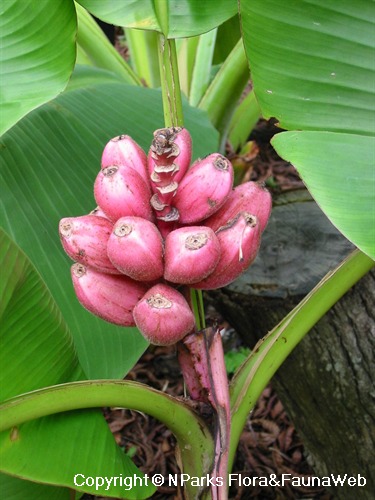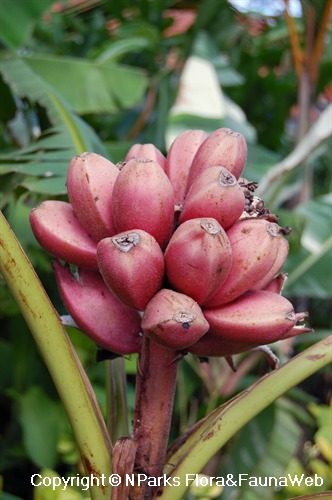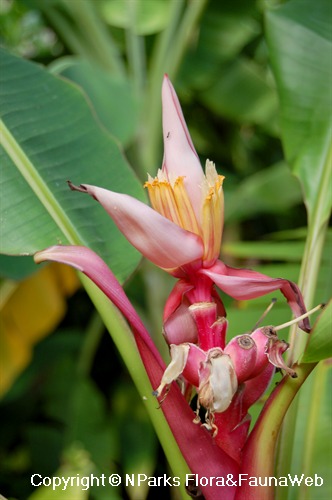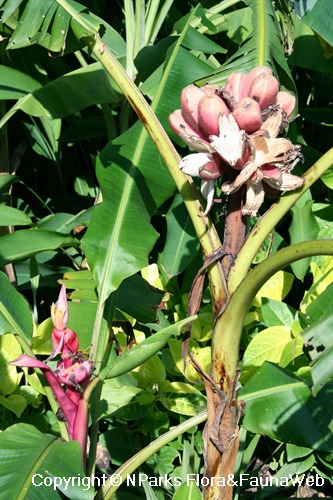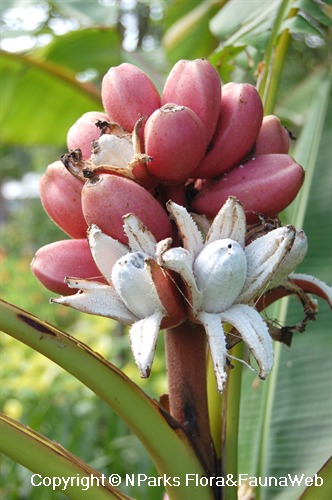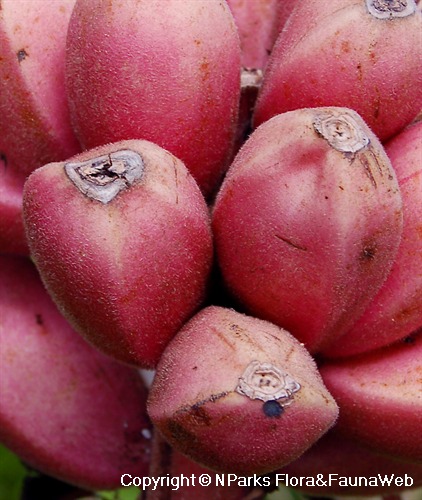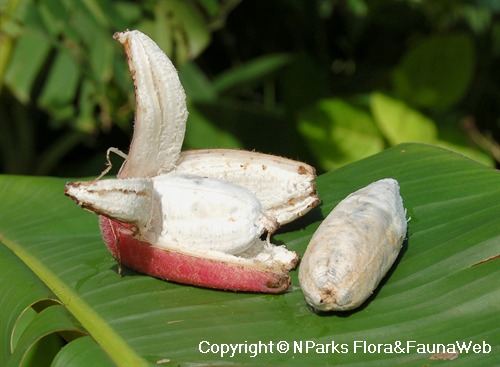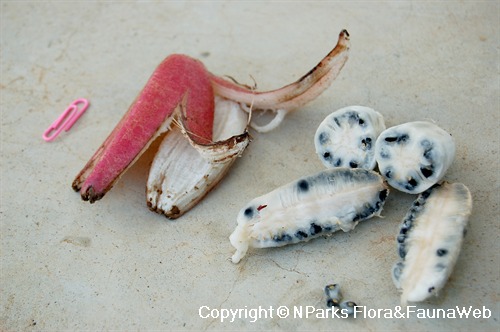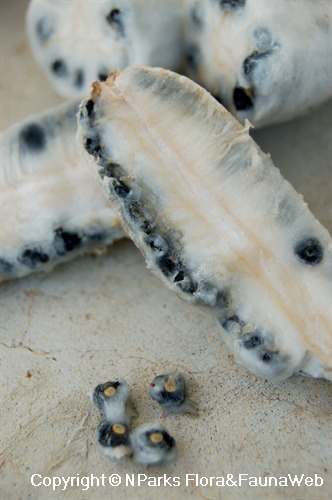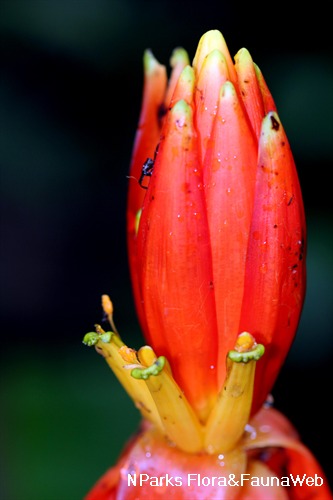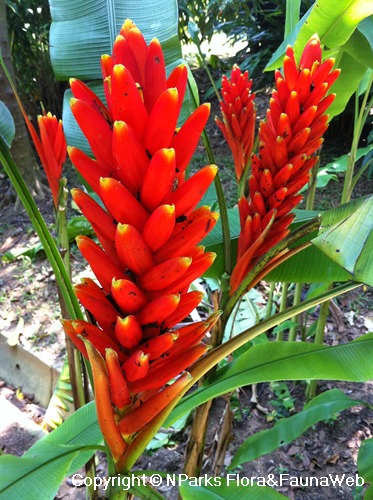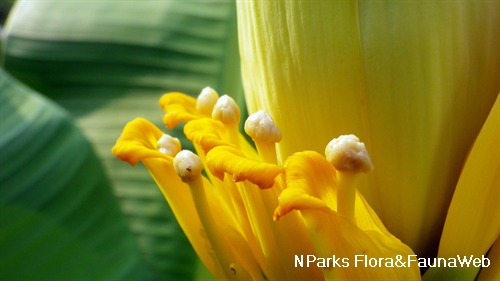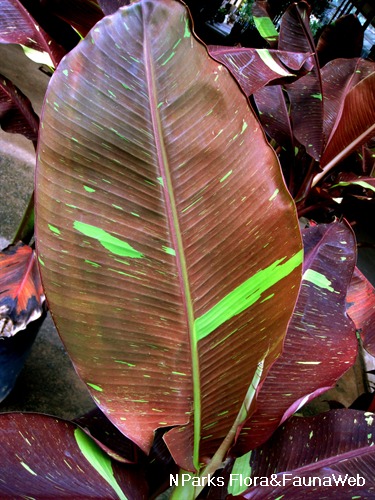.jpg)
Back
Musa velutina H. Wendl. & Drude
| Family Name: | Musaceae |
| Synonyms: | Musa dasycarpa |
| Common Name: | Velvet Pink Banana, Hairy Banana, Pink Fruiting Banana, Self-peeling Banana |
Musa velutina is an ornamental banana known as Velvety Pink Banana. Growing up to 1.5 m tall, it has light pink bracts, yellow flowers and red fruits. The fruits are sweet and edible that splits when ripe. Velvety Pink Banana is suitable to be grown in containers and with adequate sunlight, it flowers freely year-round.
Name
Classifications and Characteristics
| Plant Division | Angiosperms (Flowering Seed Plants) (Monocotyledon) |
|---|---|
| Plant Growth Form | Herbaceous Plant |
| Lifespan (in Singapore) | Perennial |
| Mode of Nutrition | Autotrophic |
| Plant Shape | Shrubby |
| Maximum Height | 1.2 m to 1.8 m |
| Maximum Plant Spread / Crown Width | 0.9 m to 1.5 m |
Biogeography
| Native Distribution | Assam, East Himalaya |
|---|---|
| Native Habitat | Terrestrial |
| Preferred Climate Zone | Sub-Tropical / Monsoonal, Tropical |
| Local Conservation Status | Non-native |
Description and Ethnobotany
| Growth Form | It is a slender, short herb that grows up to 1.5 m tall. It has a yellowish-green to purplish-green pseudostem that produces suckers freely. |
|---|---|
| Foliage | Its leaves are large, green, elliptic oblong in shape, measuring between 87 – 95 x 33 – 35cm in size. Leaf edges are often torn by wind. |
| Flowers | Its flowers are monoecious, separate male and female flowers found on the same plant. Flowers are yellow to orange, enclosed within the bracts. The bracts are light pink in colour with white stripes externally. With maturity, the inflorescence will degenerate leaving only the fruits on the stalk. This plant flowers year-round. |
| Fruit | Its fruits are angular, about 8 cm long. Each ‘hand’ consists of 3 to 4 ‘fingers’. The fruits are reddish-pink covered in velvety hairs. The skin of the fruits comes off as the fruits ripen, revealing its creamy-white flesh. Fruits contain many fairly large black seeds. |
| Habitat | Occur in forests, woodlands, savanna, shrublands, inland, elevation range between 0 – 1500m. |
| Cultivation | Propagate by seeds, suckers or division. Seed-grown plants able to bear fruit in around 1 year. |
| Ethnobotanical Uses | Edible Plant Parts : Edible Fruits Food (Fruit or Vegetable) Others: Fruits reported to be edible raw, with delicious sweet taste, although the many embedded seeds have to be removed. To be eaten within one day of the skin splitting open. Flowers and leaves used in floral arrangements for a tropical look. In some parts of India, the male buds are harvested and eaten as vegetables. Leaves are used as wrapping materials or containers for food in local markets. |
Landscaping Features
| Landscaping | Suitable for small gardens and containers. May be used in interiorscapes -- one of the few banana species that can fruit while located indoors. Fast-growing and performs best in damp but well-draining soils. |
|---|---|
| Desirable Plant Features | Ornamental Flowers, Ornamental Fruits |
| Landscape Uses | Container Planting, General, Focal Plant, Interiorscape/ Indoor Plant |
| Thematic Landscaping | Economic Garden, Naturalistic Garden |
Plant Care and Propagation
| Light Preference | Semi-Shade, Full Sun |
|---|---|
| Water Preference | Lots of Water |
| Plant Growth Rate | Fast |
| Rootzone Tolerance | Fertile Loamy Soils, Well-Drained Soils |
| Maintenance Requirements | Moderate |
| Propagation Method | Seed, Sucker, Division |
Foliar
| Foliage Retention | Evergreen |
|---|---|
| Mature Foliage Colour(s) | Green |
| Mature Foliage Texture(s) | Smooth, Glossy / Shiny, Leathery |
| Foliar Type | Simple / Unifoliate |
| Foliar Arrangement Along Stem | Spiral |
| Foliar Shape(s) | Non-Palm Foliage (Lanceolate) |
| Foliar Venation | Parallel |
| Foliar Margin | Entire - Wavy / Undulate |
| Foliar Apex - Tip | Truncate |
| Typical Foliar Area | Megaphyll (>1640.25cm2 ) |
| Leaf Area Index (LAI) for Green Plot Ratio | 3.5 (Shrub & Groundcover - Monocot) |
Non - Foliar and Storage
| Stem Type & Modification | Herbaceous |
|---|---|
| Root Type | Underground (Fibrous Root) |
| Specialised Storage Organ(s) | Underground (Rhizome) |
Floral (Angiosperm)
| Flower & Plant Sexuality | Bisexual Flowers , Monoecious |
| Flower Colour(s) | Pink, Yellow / Golden |
|---|
| Flower Grouping | Cluster / Inflorescence |
| Flower Location | Terminal |
| Flower Symmetry | Radial |
| Individual Flower Shape | Tubular |
| Flowering Period | Free-Flowering |
| Flowering Habit | Polycarpic |
Fruit, Seed and Spore
| Mature Fruit Colour(s) | Pink |
|---|---|
| Fruit Classification | Simple Fruit |
| Fruit Type | Fleshy Fruit , Berry |
Image Repository
Others
| Master ID | 954 |
|---|---|
| Species ID | 2248 |
| Flora Disclaimer | The information in this website has been compiled from reliable sources, such as reference works on medicinal plants. It is not a substitute for medical advice or treatment and NParks does not purport to provide any medical advice. Readers should always consult his/her physician before using or consuming a plant for medicinal purposes. |

.jpg)
.jpg)
.jpg)
.jpg)
